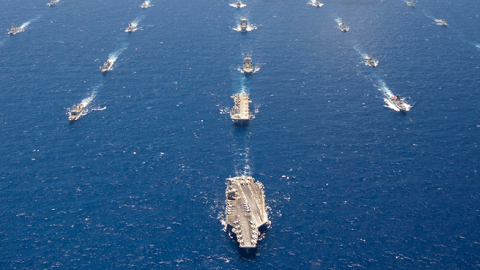As the United States winds down from two regional land conflicts that have dominated the 21st century, great power competition with China and Russia rightly dominates defense planning and operations. Consequently, American seapower must once again evolve to meet the challenges of sustaining America’s prosperity and security in a multi-polar world. No element of modern seapower is more worthy of evolution than the operational relationship between the Navy and Marine Corps, and this essay asserts that the twentieth century approach to command and control (C2) of these forces must embrace the integrated approach offered by the Joint functional commander concept and its maritime instantiation, the Joint Forces Maritime Component Commander (JFMCC).
The Department of the Navy includes two Armed Services, the Navy and Marine Corps, which together deliver American power and influence from the sea. This power and influence spans the range of military operations—from peacetime presence through great power war—accomplished by controlling the seas and projecting power therefrom. No other element of American military power is as flexible, useful, persistent, and ready as the seapower delivered by the Department of the Navy.
How the Navy and Marine Corps operate to deliver integrated American seapower has evolved over time, but for much of the twentieth century, naval doctrine for amphibious operations (an important subset of American seapower) featured two co-equal commanders whose authority was tied to the phase of a specified amphibious operation, while other naval task forces operated under the Combined Warfare Concept (CWC).
The Commander, Amphibious Task Force (CATF) was a Navy officer whose overall command of an amphibious operation existed when the force was primarily a seaward force, and the Commander, Landing Force (CLF) was a Marine Corps officer whose overall command of an amphibious operation existed during the landward phase of the operation. Each supported the other during the phase in which the other predominated. This approach to amphibious warfare was developed at the Naval War College in the 1920s and has existed with minor variation ever since.
Interestingly, the amphibious force (AF) existed mostly outside of larger naval command and control constructs. Because of the uniqueness and complexity of amphibious operations, the CATF-CLF relationship not only endured, but did so even as larger command and control constructs governing naval forces (the Navy’s Composite Warfare Commander (CWC) and the Joint Force Maritime Component Commander (JFMCC) construct) grew in importance. Organizational tension existed when attempting to integrate amphibious operations into either the Navy’s CWC or the Joint functional command relationship, mostly due to the degree to which amphibious forces had been operating independently from larger Navy formations. What developed as a temporary, mission specific C2 structure (CATF/CLF), morphed over the decades into the prevailing approach to amphibious force operations, whether an amphibious objective had been assigned or not, and when those operations bumped up against larger naval operations, amphibious forces were inelegantly integrated. For example, the capabilities of the embarked Marine Expeditionary Unit (including attack helicopters and fixed wing aircraft) were available for maritime use only in emergency conditions under a concept known as “Emergency Defense of the Amphibious Task Force.”
The Navy and Marine Corps experimented in the first part of this century on a blended C2 structure within the Expeditionary Strike Group (ESG) concept in which traditional amphibious forces (an Amphibious Ready Group (ARG) of three ships and an embarked Marine Expeditionary Unit (MEU)) were supplemented by a few surface combatants to create a strike group optimized for littoral power-projection. A traditional CWC was implemented with a Navy flag officer or Marine Corps general officer (and staff) acting as the Officer in Tactical Command (OTC). The CATF-CLF arrangement continued within this broader C2 structure as the defining command arrangement of amphibious operations, which by the nature of the ESG concept was to be only one of many missions undertaken. That said, the CATF-CLF approach continued to dominate the arrangement of forces, as the embarked U.S. Marine Corps forces remained under the control of the CLF and could be called upon for maritime missions only under emergency circumstances.
The ESG concept was largely abandoned in the past few years, as a paucity of escort combatants stressed the force in trying to meet the growing objectives asked of it. Navy and Marine Corps forces deploy today similarly to how they did in the 1990s, with the ARG/MEU training and certifying separately from aircraft carrier strike forces, and combined operations occurring infrequently and inelegantly. Additionally, once the ARG/MEU deploys overseas, it is common for the formation to be split and disaggregated in order to meet myriad combatant commander objectives concurrently.
Renewed great power competition calls for a closer look at the Navy and Marine Corps team’s operational approach, one that stresses the integrated nature of American seapower and leverages a tried and tested command and control (C2) structure. To that end, the services should begin to more closely embrace the Joint functional control approach to C2, one in which a Joint Forces Maritime Component Commander of appropriate rank and staffing exercises operational control (OPCON) and tactical control (TACON) of all forces within the ARG/MEU (as well as all other naval forces assigned), until such time as those forces are re-allocated in a campaign to another functional commander (Joint Forces Land Component Commander—JFLCC, or Joint Forces Air Component Commander—JFACC).
Under this arrangement, a Navy flag officer or Marine general officer would exercise authority over all the assets of the formation, irrespective of the service contributing them. The basic approach of the Navy’s CWC could convey with the ground force assigned to a Marine Corps commander and the air wing parceled out to other commanders (Surface, Air, Information) as the need arises. When an actual amphibious objective is designated, the CATF/CLF arrangement would apply, although these would be administrative titles rather than implying C2 authorities. The JFMCC would have a variety of capabilities to apply to the battlespace, including ground forces, surface and subsurface forces, and air forces. In essence, the JFMCC would be a “Joint Task Force” commander. Should the ground objective be part of a larger land campaign, Marine forces would “chop” to the JFLCC, but for amphibious operations of more limited duration, the JFMCC would be the functional commander exercising OPCON of those forces.
Embracing the Joint functional approach to C2 of naval forces offers several advantages over the current approach. First, it would drive integration at the operational level that does not currently exist. Most of the nation’s critical peacetime presence missions around the world can be more than adequately serviced by the forces of the Department of the Navy and integrating those forces under a single commander aligns with the principles of war and makes for more efficient operations.
Next, by integrating these forces under the JFMCC, pressure will grow to integrate operational architectures and concepts of operation, which would influence the acquisition community to provide weapons, networks, and sensors that serve a more coherent architecture, rather than the more separated service approaches that characterize the present. Communications and networks will necessarily benefit from co-development, but another benefit would be to highlight the lack of offensive power resident in ships of the amphibious force. An empowered JFMCC would look with interest upon the maritime real estate provided by the capacious decks of modern amphibious ships and wonder why there were not over-the-horizon missiles capable of land-attack and anti-ship engagements.
A third advantage is related to the second. Currently, the (Navy purchased and operated) ships of the amphibious force are thought of as transportation for and support to U.S. Marines ashore. It is axiomatic that the Commandant of the Marine Corps spends more time thinking about amphibious ship numbers than the Chief of Naval Operations does. Were these ships and their capabilities seen to be the province of the maritime commander—rather than simply support for land operations—more attention would be paid to their numbers, their capabilities, their readiness, and their place in the broader naval force architecture.
Conclusion
The Navy and Marine Corps provide the nation with the world’s most powerful and mobile air forces, the world’s most feared middleweight land force, and the world’s most lethal surface and submarine forces. Thought of as an integrated whole and operated under a coherent C2 arrangement, these forces offer the prospect of servicing most of the nation’s security needs forward, even as they protect and sustain America’s prosperity by commanding the maritime commons. Embracing the JFMCC functional approach to command and control of Department of the Navy forces offers the best option to accomplish this operational integration, which will then serve to drive bureaucratic, technical, and intellectual integration within the Department.



















